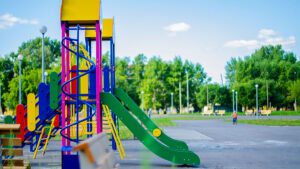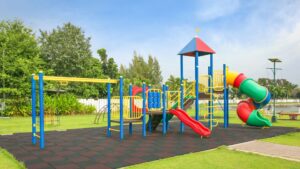Les balançoires d'aires de jeux sont des favorites intemporelles qui suscitent la joie, encouragent le jeu social et favorisent le développement physique des enfants de tous âges. Les parcs modernes s'efforcent d'offrir une gamme variée de styles de balançoires - balançoires à courroie classiques, balançoires à godet adaptées aux tout-petits, balançoires adaptatives inclusives, et plus encore - afin de s'assurer que chaque enfant puisse s'amuser. Dans ce guide, nous allons explorer les types de balançoires les plus populaires, leurs caractéristiques, les considérations de sécurité et les conseils d'entretien, afin d'aider les planificateurs de parcs et les parents à choisir les balançoires parfaites pour leurs espaces de jeu.
1. Introduction
Les balançoires sont plus qu'un simple amusement : elles favorisent l'équilibre, la coordination et la force musculaire tout en offrant aux enfants un sentiment de liberté. Les communautés mettant l'accent sur l'intégration et la sécurité, les concepteurs d'aires de jeux installent désormais divers types de balançoires, chacune adaptée à des groupes d'âge et à des capacités différents. Comprendre les caractéristiques et les exigences propres à chaque type de balançoire vous aidera à créer une aire de jeux à la fois attrayante et accessible.
2. Balançoires à courroie
Également connu sous le nom de : Balançoires traditionnelles, balançoires à siège en caoutchouc
Vue d'ensemble :
- Modèle classique monoplace avec une ceinture souple en caoutchouc ou en tissu renforcé.
- Longueur de chaîne ou de corde réglable pour les enfants en bas âge, les adolescents et les adultes.
Caractéristiques et avantages :
- Polyvalence : Convient aux personnes âgées de 3 à 99 ans, supporte jusqu'à 250 livres.
- Durabilité : Les matériaux résistants aux UV et aux intempéries ne se fissurent pas.
- Accès facile : Hauteur d'assise basse pour un montage autonome.
Considérations de sécurité :
- Inspecter mensuellement l'usure du matériel de fixation et des chaînes.
- Veiller à ce que l'arc de rotation soit dégagé (au moins 30 pouces de chaque côté).
- Installer sur un revêtement absorbant les chocs (paillis de caoutchouc, fibre de bois).

3. Balançoires à seaux (pour bébés)
Également connu sous le nom de : Balançoires pour tout-petits, balançoires pour bébés
Vue d'ensemble :
- Siège à haut dossier avec ouvertures pour les jambes et sangles de sécurité.
- Empêche les jeunes enfants de glisser pendant la balançoire.
Caractéristiques et avantages :
- Ajustement sûr : Harnais réglable ou dispositif de retenue en T.
- Soutien au développement : Le balancement doux stimule le système vestibulaire.
- Les liens entre parents et enfants : Permet aux soignants de pousser et d'interagir.
Considérations de sécurité :
- La limite de poids est généralement de 50 livres ; à retirer au fur et à mesure que l'enfant prend de l'assurance.
- Vérifier régulièrement l'intégrité de la courroie et les mécanismes de serrage.
- Surveillez les enfants en bas âge à tout moment.

4. Balançoires à glissière
Également connu sous le nom de : Balançoires en tandem, balançoires pour deux personnes
Vue d'ensemble :
- Siège en forme de banc conçu pour deux ou plusieurs utilisateurs se faisant face.
- Se déplace d'avant en arrière le long d'une poutre ou d'un bras fixe.
Caractéristiques et avantages :
- Jeu social : Encourage les enfants à pousser et à rouler en coopération.
- Exercice modéré : Fait travailler les muscles du haut du corps et des jambes pour la poussée.
- Mouvement unique : Le bercement rythmique plaît à tous les âges.
Considérations de sécurité :
- Sécuriser les repose-pieds et les poignées pour éviter les glissades.
- Maintenir une piste de glisse lisse ; éliminer les débris.
- Limiter à la capacité recommandée pour l'utilisateur.

5. Balançoires adaptatives (inclusives)
Également connu sous le nom de : Balançoires accessibles, balançoires adaptées aux personnes handicapées
Vue d'ensemble :
- Sièges spécialement conçus (baquet complet, banquette avec dossier, harnais).
- S'adapte aux enfants ayant des difficultés de mobilité ou des sensibilités sensorielles.
Caractéristiques et avantages :
- Inclusion : Permet aux enfants de tous niveaux de se balancer en toute sécurité.
- Sièges de soutien : Soutien dorsal et ceintures supplémentaires.
- Intégration communautaire : Favorise des environnements de jeu inclusifs.
Considérations de sécurité :
- Utilisez des harnais à 5 points pour plus de stabilité.
- Installer sur des surfaces planes et fermes avec des allées conformes aux normes ADA.
- Prévoir des sièges à proximité pour les soignants.

6. Balançoires à pneus
Également connu sous le nom de : Balançoires rotatives, balançoires à pneus recyclés
Vue d'ensemble :
- Pneu de véhicule recyclé suspendu horizontalement ou verticalement par des chaînes.
- Plusieurs enfants peuvent s'asseoir ou se tenir debout.
Caractéristiques et avantages :
- Respectueux de l'environnement : Réutilisation des vieux pneus, ce qui réduit les déchets.
- Multi-utilisateurs : Encourage le jeu en groupe et le partage.
- Entrée sensorielle : Procure des sensations de rotation et de balancement.
Considérations de sécurité :
- Lisser la surface intérieure du pneu ou ajouter un rembourrage pour éviter les points de pincement.
- Vérifier l'intégrité du pneu en recherchant des coupures ou des points faibles.
- Dégager la zone environnante de tout obstacle.

7. Balançoires à nid (panier)
Également connu sous le nom de : Balançoires nid d'oiseau, balançoires hamac
Vue d'ensemble :
- Grand filet circulaire ou lit en tissu suspendu à un cadre.
- Permet à plusieurs enfants de s'allonger ou de s'asseoir ensemble.
Caractéristiques et avantages :
- Interaction de groupe : Favorise le jeu social et coopératif.
- Confort : Une expérience de détente douce, semblable à celle d'un hamac.
- Respectueux des sens : Le bercement doux est apaisant pour les personnes qui recherchent des sensations.
Considérations de sécurité :
- Capacité de poids jusqu'à 600 livres ; limiter les utilisateurs en conséquence.
- Inspecter la sangle pour vérifier qu'elle n'est pas effilochée ou déchirée.
- Veillez à ce que le poids soit réparti uniformément afin d'éviter tout basculement.

8. Balançoires à disques et à soucoupes
Également connu sous le nom de : Balançoires à soucoupe volante, balançoires à nacelle
Vue d'ensemble :
- Plate-forme circulaire monoplace en plastique ou en tissu.
- Balancement réalisé à l'aide d'une corde ou d'une chaîne, permettant souvent de tourner.
Caractéristiques et avantages :
- Facteur d'amusement : Combine le balancement et le mouvement de rotation.
- Encombrement réduit : Convient aux petites aires de jeu.
- Usage unique ou double : Certains modèles peuvent accueillir deux enfants.
Considérations de sécurité :
- S'assurer que la balançoire est libre de tourner sans s'emmêler.
- Maintenir des connexions fluides entre la corde et la chaîne.
- Superviser la filature afin de prévenir les chutes liées aux vertiges.

9. Balançoires familiales en chaîne
Également connu sous le nom de : Balançoires à plate-forme, balançoires de groupe
Vue d'ensemble :
- Grande plate-forme rectangulaire ou triangulaire suspendue par de multiples chaînes.
- Conçu pour le balancement des groupes ou l'accès des fauteuils roulants.
Caractéristiques et avantages :
- Conception universelle : Les fauteuils roulants et les poussettes sont acceptés.
- Jeu en groupe : Parfait pour la poussée collaborative et la socialisation.
- Construction robuste : Chaînes robustes et plate-forme durable.
Considérations de sécurité :
- Confirmer la conformité à l'ADA pour les utilisateurs de fauteuils roulants.
- Inspecter les suspensions multiples pour vérifier qu'elles s'usent uniformément.
- Installer des garde-corps sur les bords de la plate-forme.

10. Conseils de sécurité et entretien
Inspections régulières :
- Contrôles visuels hebdomadaires de l'usure, de la corrosion et des boulons desserrés.
- Des tests de fonctionnement mensuels garantissent un mouvement de balancier en douceur.
Exigences de surface :
- Zone libre de 6 pieds devant et derrière chaque balançoire.
- Revêtement absorbant les chocs (paillis de caoutchouc, caoutchouc coulé, sable) à une profondeur d'au moins 12 pouces.
Entretien du matériel :
- Lubrifier les pièces mobiles pour éviter les grincements et le grippage.
- Remplacez immédiatement les chaînes ou les câbles usés.
Lignes directrices à l'intention des utilisateurs :
- Afficher les limites d'âge et de capacité sur les balançoires.
- Encouragez les enfants à se balancer en file indienne et à ne pas sauter de leur siège.
L'hivernage :
- Retirer la ceinture et les sièges souples en cas de gel.
- Couvrir les éléments métalliques ou appliquer une peinture antirouille.

11. Conclusion
Choisir la bonne combinaison de balançoires d'aire de jeux permet de s'amuser, d'encourager le jeu inclusif et de soutenir le développement physique et social des enfants. Des balançoires classiques à courroie aux sièges adaptatifs spécialisés, chaque type de balançoire offre des avantages et des considérations de conception uniques. En respectant les consignes de sécurité et en procédant à un entretien régulier, les parcs et les aires de jeux peuvent constituer un environnement dynamique et accueillant où chaque enfant peut goûter au simple plaisir de se balancer.




